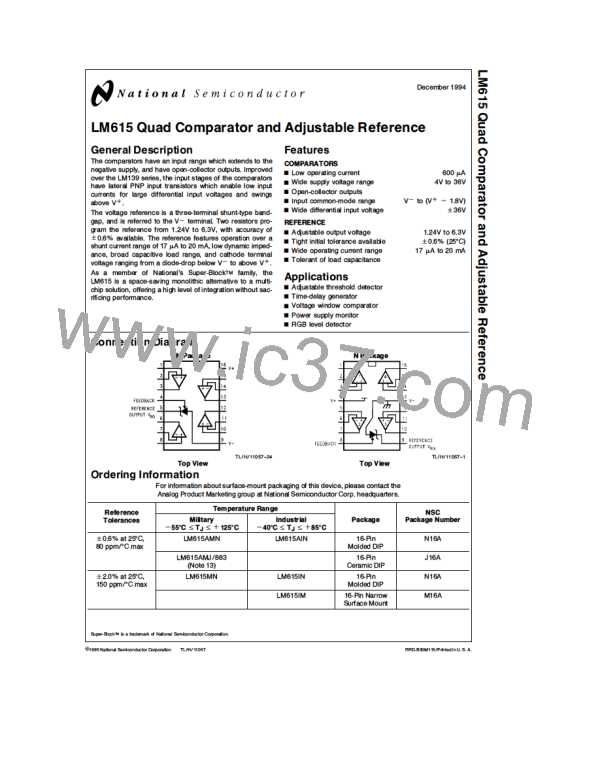Electrical Characteristics
GND
a
These specifications apply for Vb
GND, unless otherwise specified. Limits in standard typeface are for T
Operating Temperature Range. (Continued)
0V, V
5V, V
CM
V
V
a/2, I
25 C; limits in boldface type apply over the
100 mA, FEEDBACK pin shorted to
e
e
e
e
e
e
e
R
OUT
§
J
LM615AM
LM615AI
Limits
LM615M
LM615I
Limits
Typical
Symbol
Parameter
Conditions
Units
(Note 7)
(Note 8)
(Note 8)
VOLTAGE REFERENCE (Note 9)
V
R
Reference
Voltage
1.244
1.2365
1.2515
1.2191
1.2689
V min
V max
g
g
2%)
(
0.6%)
(
DV
Average Drift
(Note 10)
(Note 11)
ppm/ C
§
max
R
18
80
150
with Temperature
DT
DV
e
e
Average Drift
with Time
T
T
40 C
§
150 C
400
ppm/kH
ppm/kH
R
J
1000
kH
§
J
DV
Hysteresis
R
3.2
mV/ C
§
DT
DV
J
b
V
R
Change
V
V
V
0.05
1
1
mV max
mV max
R
[
]
[
]
R 100 mA
R 17 mA
with Current
0.1
1.1
1.1
DI
R
b
V
1.5
5
5
mV max
mV max
[
]
[
]
R 10 mA
R 100 mA
(Note 12)
2.0
5.5
5.5
R
Resistance
DV
DV
/9.9 mA
]
0.2
0.6
0.56
13
0.56
13
X max
X max
[
R 10 mA to 0.1 mA
/83 mA
]
[
R 100 mA to 17 mA
b
DV
DV
V
Change
V
V
2.5
5
5
mV max
mV max
e
e
R
[
R V
]
[
R V
RO
]
6.3V
R
V
5V
5V
RO
R
with V
2.8
10
10
RO
RO
b
DV
V
R
Change
V
[
R V
V
0.1
1.2
1.2
mV max
mV max
a e
a e
a e
a e
R
]
]
[
R V
]
36V
with Va Change
0.1
1.3
1.3
DVa
b
V
[
R V
V
0.01
1
1
mV max
mV max
[
R V
]
3V
0.01
1.5
1.5
Vb
BW
V
22
35
50
nA max
nA max
s
s
5.06V
I
FEEDBACK
Bias Current
FB
FB
29
40
55
e
e
Voltage Noise
10 Hz to 10 kHz
30
mV
RMS
n
Note 1: Absolute maximum ratings indicate limits beyond which damage to the component may occur. Electrical specifications do not apply when operating the
device beyond its rated operating conditions.
Note 2: Input voltage above Va is allowed. As long as one input pin voltage remains inside the common-mode range, the comparator will deliver the correct output.
Note 3: More accurately, it is excessive current flow, with resulting excess heating, that limits the voltages on all pins. When any pin is pulled a diode drop below
Vb, a parasitic NPN transistor turns ON. No latch-up will occur as long as the current through that pin remains below the Maximum Rating. Operation is undefined
and unpredictable when any parasitic diode or transistor is conducting.
Note 4: Shorting an Output to Vb will not cause power dissipation, so it may be continuous. However, shorting an Output to any more positive voltage (including
V
a), will cause 80 mA (typ.) to be drawn through the output transistor. This current multiplied by the applied voltage is the power dissipation in the output transistor.
If the total power from all shorted outputs causes the junction temperature to exceed 150 C, degraded reliability or destruction of the device may occur. To
§
determine junction temperature, see Note 5.
e
a
P
Note 5: Junction temperature may be calculated using T
T
i
. The given thermal resistance is worst-case for packages in sockets in still air. For
JA
J
A
D
packages soldered to copper-clad board with dissipation from one comparator or reference output transistor, nominal i is 80 C/W for the N package.
§
JA
Note 6: Human body model, 100 pF discharge through a 1.5 kX resistor.
e
Note 7: Typical values in standard typeface are for T
25 C; values in boldface type apply for the full operating temperature range. These values represent the
§
J
most likely parametric norm.
e
a
25 C (standard type face) or over the full operating temperature range (bold type face).
Note 8: All limits are guaranteed for T
§
J
Note 9: V
is the reference output voltage, which may be set for 1.2V to 6.3V (see Application Information). V is the V -to-FEEDBACK voltage (nominally
RO
RO
R
1.244V).
Note 10: Average reference drift is calculated from the measurement of the reference voltage at 25 C and at the temperature extremes. The drift, in ppm/ C, is
§
§
6
10
DV /V
DT , where DV is the lowest value subtracted from the highest, V
#
is the value at 25 C, and DT is the temperature range. This
§
]
R 25 C J
#
parameter is guaranteed by design and sample testing.
[
R 25 C
]
[
R
J
R
§
§
Note 11: Hysteresis is the change in V caused by a change in T , after the reference has been ‘‘dehysterized.’’ To dehysterize the reference; that is minimize the
b
RO J
hysteresis to the typical value, its junction temperature should be cycled in the following pattern, spiraling in toward 25 C: 25 C, 85 C, 40 C, 70 C, 0 C, 25 C.
§
§
§
§
§
§
§
Note 12: Low contact resistance is required for accurate measurement.
Note 13: A military RETS electrical test specification is available on request. The LM615AMJ/883 may also be procured as a Standard Military Drawing.
3

 NSC [ National Semiconductor ]
NSC [ National Semiconductor ]